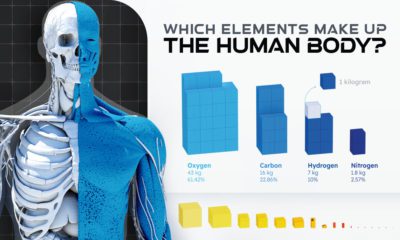While cities are the main drivers for improving the lives of people and entire nations, they also tend to be the main contributors of pollution and CO2 emissions. How can we encourage this growth, while also making city energy use sustainable?
Resolving the Paradox
Today’s infographic comes to us from the Canadian Hydrogen and Fuel Cell Association and it outlines hydrogen technology as a sustainable fuel for keeping urban economic engines running effectively for the future.
The Urban Economic Engine
Today, more than half of the world’s population lives in cities, and according to U.N. estimates, that number will grow to 6.7 billion by 2050 – or about 68% of the global population.
Simultaneously, it is projected that developing economies such as India, Nigeria, Indonesia, Brazil, China, Malaysia, Kenya, Egypt, Turkey, and South Africa will drive global growth.
Development leads to urbanization which leads to increased economic activity:
The difficulty in this will be achieving a balance between growth and sustainability. Currently, cities consume over two-thirds of the world’s energy and account for more than 70% of global CO2 emissions to produce 80% of global GDP. Further, it’s projected by the McKinsey Global Institute that the economic output of the 600 largest cities and urban regions globally could grow $30 trillion by the year 2050, comprising for two-thirds of all economic growth. With this growth will come increased demand for energy and C02 emissions.
The Hydrogen Fueled City
Hydrogen, along with fuel cell technology, may provide a flexible energy solution that could replace the many ways fossils fuels are used today for heat, power, and transportation.
When used, it creates water vapor and oxygen, instead of harmful smog in congested urban areas.
According to the Hydrogen Council, by 2050, hydrogen could each year generate:
1,500 TWh of electricity 10% of the heat and power required by households Power for a fleet of 400 million cars
The infrastructure requirements for hydrogen make it easy to distribute at scale. Meanwhile, for heat and power, low concentrations of hydrogen can be blended into natural gas networks with ease.
Hydrogen can play a role in improving the resilience of renewable energy sources such as wind and solar, by being an energy carrier. By taking surplus electricity to generate hydrogen through electrolysis, energy can be stored for later use.
In short, hydrogen has the potential to provide the clean energy needed to keep cities running and growing while working towards zero emissions.
on
#1: High Reliability
Nuclear power plants run 24/7 and are the most reliable source of sustainable energy. Nuclear electricity generation remains steady around the clock throughout the day, week, and year. Meanwhile, daily solar generation peaks in the afternoon when electricity demand is usually lower, and wind generation depends on wind speeds.As the use of variable solar and wind power increases globally, nuclear offers a stable and reliable backbone for a clean electricity grid.
#2: Clean Electricity
Nuclear reactors use fission to generate electricity without any greenhouse gas (GHG) emissions.Consequently, nuclear power is the cleanest energy source on a lifecycle basis, measured in CO2-equivalent emissions per gigawatt-hour (GWh) of electricity produced by a power plant over its lifetime. The lifecycle emissions from a typical nuclear power plant are 273 times lower than coal and 163 times lower than natural gas. Furthermore, nuclear is relatively less resource-intensive, allowing for lower supply chain emissions than wind and solar plants.
#3: Stable Affordability
Although nuclear plants can be expensive to build, they are cost-competitive in the long run. Most nuclear plants have an initial lifetime of around 40 years, after which they can continue operating with approved lifetime extensions. Nuclear plants with lifetime extensions are the cheapest sources of electricity in the United States, and 88 of the country’s 92 reactors have received approvals for 20-year extensions. Additionally, according to the World Nuclear Association, nuclear plants are relatively less susceptible to fuel price volatility than natural gas plants, allowing for stable costs of electricity generation.
#4: Energy Efficiency
Nuclear’s high energy return on investment (EROI) exemplifies its exceptional efficiency. EROI measures how many units of energy are returned for every unit invested in building and running a power plant, over its lifetime. According to a 2018 study by Weissbach et al., nuclear’s EROI is 75 units, making it the most efficient energy source by some distance, with hydropower ranking second at 35 units.
#5: Sustainable Innovation
New, advanced reactor designs are bypassing many of the difficulties faced by traditional nuclear plants, making nuclear power more accessible.
Small Modular Reactors (SMRs) are much smaller than conventional reactors and are modular—meaning that their components can be transported and assembled in different locations. Microreactors are smaller than SMRs and are designed to provide electricity in remote and small market areas. They can also serve as backup power sources during emergencies.
These reactor designs offer several advantages, including lower initial capital costs, portability, and increased scalability.
A Nuclear-Powered Future
Nuclear power is making a remarkable comeback as countries work to achieve climate goals and ultimately, a state of energy utopia. Besides the 423 reactors in operation worldwide, another 56 reactors are under construction, and at least 69 more are planned for construction. Some nations, like Japan, have also reversed their attitudes toward nuclear power, embracing it as a clean and reliable energy source for the future. CanAlaska is a leading exploration company in the Athabasca Basin, the Earth’s richest uranium depository. Click here to learn more now. In part 3 of the Road to Energy Utopia series, we explore the unique properties of uranium, the fuel that powers nuclear reactors.






























